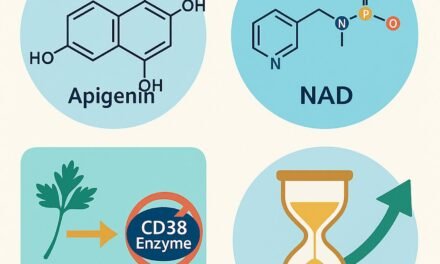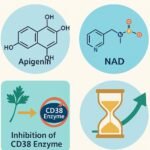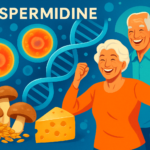Introduction to Biological Aging
What is Biological Aging?
Biological aging isn’t just about getting wrinkles or grey hair. It’s the gradual and progressive decline in how our bodies function on the inside — from the way our cells communicate to how our organs perform. Unlike chronological age, which simply counts how many birthdays you’ve had, biological aging reflects the “real” age of your cells, tissues, and organs.
Every second, cells in your body are dealing with DNA damage, oxidative stress, and metabolic waste. As we age, our bodies lose the efficiency to repair and rejuvenate at the same pace. Mitochondria, the powerhouses of cells, start failing. Stem cells reduce in number and function. Inflammatory processes increase. This cocktail of changes lays the groundwork for age-related issues like arthritis, dementia, diabetes, and cardiovascular diseases.
But here’s the good news: recent science is showing that biological aging can be influenced — even slowed — by targeted nutrition, lifestyle interventions, and key molecules like C15:0.
Difference Between Chronological and Biological Age
Chronological age is just a number. Biological age is a reflection of your cellular vitality. You could be 60 years old chronologically, but if your body’s systems are functioning like that of a 40-year-old, you have a younger biological age — and vice versa.
So, what affects biological age? Factors like sleep, diet, stress levels, toxin exposure, and exercise play massive roles. Modern testing, like epigenetic clocks and telomere length assessments, can now give us a peek into our real “inner age.”
What’s fascinating is that interventions targeting cellular health — such as improving mitochondrial function and reducing inflammation — have been shown to decrease biological age. And that’s where molecules like C15:0 come in.
Key Drivers of Aging at the Cellular Level
To truly understand how to slow biological aging, we need to know the enemy. Aging at the cellular level is mainly driven by:
- Mitochondrial decline: As we age, these energy factories produce less energy and more reactive oxygen species (ROS), which can damage cells.
- Chronic inflammation: Also known as “inflammaging,” it’s a state of persistent low-level inflammation that damages tissues and impairs function.
- DNA damage: Accumulated over time due to environmental stressors and internal processes.
- Telomere shortening: Telomeres are protective caps on chromosomes. Every time a cell divides, they get shorter until the cell can no longer divide.
- Senescence: Old, damaged cells that stop dividing but refuse to die. They release harmful substances that damage nearby healthy cells.
Now, scientists are identifying compounds that can help slow or even reverse these processes — and C15:0 is gaining recognition as one of them.
Meet C15:0 – The Odd-Chain Saturated Fatty Acid
What is C15:0?
C15:0, or pentadecanoic acid, is a long-chain, odd-chain saturated fatty acid that’s naturally found in small amounts in full-fat dairy products and some types of fish. For decades, saturated fats were painted as villains in the story of nutrition. But not all saturated fats are created equal. C15:0 is turning that narrative on its head.
Unlike even-chain saturated fats, which are linked to metabolic diseases when overconsumed, C15:0 is an odd-chain saturated fat — and it behaves very differently in the body. It has been found to support cellular function, reduce inflammation, and even lengthen lifespan in some animal models.
Scientists now consider it a “pro-longevity” nutrient, one that supports metabolic health and overall well-being. It’s even being touted as the first essential fatty acid to be discovered since omega-3s.
How C15:0 Was Discovered as a Health-Promoting Molecule
The discovery of C15:0’s health benefits was accidental. While researchers were studying blood markers in long-lived individuals and animals, they noticed that those with higher levels of odd-chain fatty acids — particularly C15:0 — had better metabolic health and lower inflammation.
Further lab studies revealed that C15:0 had the ability to:
- Activate AMPK and PPAR pathways (key metabolic regulators)
- Reduce pro-inflammatory cytokines
- Improve mitochondrial function
- Increase cell membrane stability
These mechanisms all point toward one thing: a potential slow-down in the biological aging process.
Natural Sources of C15:0 in Diet
Getting C15:0 from your diet is possible but tricky. It’s primarily found in:
- Full-fat dairy products like whole milk, butter, and cheese
- Certain types of fish, such as salmon and sardines
- Lamb and beef, particularly from grass-fed animals
However, the modern push toward low-fat and dairy-free diets has significantly reduced the population’s intake of C15:0. Some people may also avoid these foods for ethical, health, or dietary reasons, which can lead to insufficient levels of this nutrient.
That’s why supplementation is becoming a more popular and accessible route for people interested in reaping its anti-aging benefits without drastically altering their diet.
C15:0 and Cellular Health
Mitochondrial Support and Energy Production
Mitochondria are like tiny batteries powering every cell in your body. As you age, these batteries begin to weaken. But research shows C15:0 can help recharge them.
Studies reveal that C15:0 improves mitochondrial function by enhancing the efficiency of the electron transport chain. This means better ATP (energy) production, less oxidative damage, and overall more energetic, youthful cells.
One of the key mechanisms here is C15:0’s ability to activate AMPK — the “master switch” for cellular energy. Activating AMPK helps increase mitochondrial biogenesis (the creation of new mitochondria), which plays a crucial role in reversing age-related energy decline.
People who start supplementing with C15:0 often report increased vitality, better focus, and reduced fatigue — all signs of a healthier mitochondrial network.
Strengthening Cell Membranes
Healthy cells need strong, flexible membranes to function properly. Think of membranes as the gatekeepers that control what enters and exits the cell. As we age, these membranes become less effective — leading to leaky cells, inefficient communication, and vulnerability to toxins.
C15:0 has been found to integrate into cell membranes, making them more stable and resilient. Unlike other fats, it doesn’t oxidize easily, meaning it can protect cells from free radical damage.
This is especially important for brain cells and immune cells, which rely heavily on membrane integrity for fast signaling and effective function.
Reducing Cellular Inflammation
Chronic inflammation is a silent killer. It accelerates aging, increases the risk of nearly every disease, and damages tissues at the microscopic level. C15:0’s anti-inflammatory power comes from its ability to lower levels of pro-inflammatory cytokines such as IL-6, TNF-α, and CRP.
One of the most promising aspects of C15:0 is that it offers these anti-inflammatory effects without suppressing the immune system, unlike many pharmaceutical interventions.
This means you get the benefits of reduced inflammation — better joint function, sharper cognition, healthier skin — while still maintaining a strong defense against infections.
C15:0’s Role in Slowing Down Biological Aging
Promoting Longevity at the Cellular Level
Aging may be inevitable, but how fast and how gracefully you age is largely influenced by the health of your cells. C15:0 supports cellular longevity through multiple mechanisms that all converge on one result — extending the healthy life span of your cells, and by extension, your entire body.
One of the primary ways it achieves this is by enhancing the process of autophagy — the body’s built-in recycling system that clears out damaged cells and cellular components. As we age, autophagy slows down, leading to an accumulation of dysfunctional proteins and organelles. C15:0 has been shown to promote this cleansing process, essentially giving your cells a fresh start.
C15:0 also increases telomerase activity. Telomerase is an enzyme that helps maintain telomere length — the protective ends of DNA strands that shorten as we age. Longer telomeres are associated with slower biological aging, and some studies suggest C15:0 helps preserve these critical markers of youth.
Protecting Against Age-Related Diseases
There’s a strong correlation between aging and the onset of chronic diseases such as:
- Type 2 diabetes
- Cardiovascular disease
- Alzheimer’s disease
- Osteoporosis
- Cancer
C15:0 helps shield against these illnesses by addressing root causes rather than just symptoms. Its anti-inflammatory and metabolic-regulating properties improve insulin sensitivity, lower blood sugar levels, and stabilize blood pressure.
Animal studies have even shown that C15:0 supplementation can reduce the progression of metabolic syndrome, a cluster of conditions including obesity, insulin resistance, and high triglycerides. These improvements directly contribute to reducing the risk of type 2 diabetes and cardiovascular disease — two of the most common age-related illnesses.
By reducing oxidative stress and improving lipid metabolism, C15:0 also supports brain health. This has significant implications for neurodegenerative diseases like Alzheimer’s and Parkinson’s, which are often tied to age and chronic inflammation.
Enhancing Cellular Resilience to Stressors
As we age, our bodies lose the ability to bounce back from physical and emotional stress. Cellular resilience — the capacity of cells to withstand and recover from stress — diminishes. C15:0 helps reverse this decline.
Research shows that C15:0 enhances cellular plasticity, allowing cells to adapt to environmental changes more effectively. It also upregulates stress-response proteins like heat shock proteins (HSPs), which protect cells from damage caused by toxins, heat, and other stressors.
This translates to better recovery after injury, improved immunity, and greater adaptability to everyday life’s physical and emotional stresses. Essentially, your body becomes more “resilient,” functioning like that of someone much younger.
Scientific Evidence Supporting C15:0’s Anti-Aging Potential
Key Studies and Clinical Findings
Scientific interest in C15:0 has exploded over the past few years. A number of preclinical and clinical studies have demonstrated its remarkable health benefits.
For example, a landmark study published in Nature found that mice fed with a C15:0-enriched diet exhibited:
- Reduced inflammation markers
- Improved metabolic profiles
- Extended average lifespan by up to 25%
Another double-blind, placebo-controlled study in humans showed that individuals supplementing with C15:0 had improved markers of metabolic health, including reduced CRP (C-reactive protein) levels — a key indicator of systemic inflammation.
What’s most promising is that many of these benefits occurred at the cellular level within weeks of supplementation, suggesting that C15:0 doesn’t just prevent aging-related damage — it begins repairing it.
Comparing C15:0 With Omega-3 Fatty Acids
Omega-3s have long been the gold standard for healthy aging, but new evidence suggests that C15:0 may be even more potent in certain areas.
Both omega-3s and C15:0 reduce inflammation and support heart and brain health. However, studies show that C15:0:
- Has a longer half-life, meaning it stays active in the body longer
- Is more stable and less prone to oxidation
- Works at lower doses than omega-3s to achieve similar or greater effects
Moreover, C15:0 activates a broader range of cellular pathways, including PPARα and PPARδ receptors, which are critical for lipid metabolism, inflammation regulation, and mitochondrial health.
That’s not to say omega-3s are obsolete — but adding C15:0 to your health regimen may provide an extra edge in the battle against biological aging.
Addressing the Myth Around Saturated Fats
C15:0’s classification as a “saturated fat” has understandably raised eyebrows, especially in light of decades of dietary guidance warning against saturated fat consumption. But context is everything.
Most saturated fats in processed foods are even-chain fatty acids like C16:0 (palmitic acid), which are associated with inflammation and heart disease. C15:0, on the other hand, is an odd-chain saturated fatty acid — and it behaves very differently in the body.
Epidemiological studies consistently show that higher levels of odd-chain saturated fats in the blood are associated with:
- Lower risk of cardiovascular disease
- Improved insulin sensitivity
- Lower inflammation
In fact, a 2020 study concluded that C15:0 should be reclassified as a beneficial nutrient, and not lumped together with unhealthy saturated fats. This calls for a shift in nutritional policy and public perception — one that recognizes C15:0’s powerful role in promoting longevity and health.
Optimal Dosage and Supplementation
How Much C15:0 Do You Need?
While there’s no official RDA (Recommended Daily Allowance) for C15:0, most research suggests that adults need at least 100 to 300 mg per day to begin reaping the health benefits.
This amount can be difficult to obtain through diet alone, especially for those following plant-based or low-fat eating plans. A glass of whole milk, for instance, contains just about 10 mg of C15:0. To reach optimal levels, you’d have to consume significant amounts of full-fat dairy daily — which isn’t practical or advisable for many people.
That’s why C15:0 supplements are becoming an increasingly popular and practical solution for health-conscious consumers.
C15:0 Supplements vs Natural Sources
Supplements offer a concentrated, purified form of C15:0 — typically derived from plant-based or fermentation processes — without the additional calories, cholesterol, or lactose found in dairy.
Benefits of C15:0 supplements include:
- Precise dosing: Ensures consistent intake every day
- Purity: Free from additives, hormones, and dairy-related allergens
- Convenience: Easier to incorporate into busy lifestyles
However, if you do consume full-fat dairy regularly and tolerate it well, it’s possible to achieve some of the benefits through dietary intake — just be mindful of the overall saturated fat content and calorie load.
Safety Profile and Potential Side Effects
C15:0 is generally considered safe for most people when used at recommended doses. Clinical studies have shown no significant adverse effects even at doses 5–10 times higher than the estimated optimal daily amount.
Still, some individuals may experience:
- Mild digestive upset when first starting
- Interactions with medications, especially those affecting lipid metabolism
As always, it’s best to consult a healthcare professional before adding any new supplement to your routine, especially if you’re on chronic medications or have preexisting conditions.
Real-Life Applications and Benefits
Testimonials and User Experiences
Nothing underscores the power of a nutrient like real-life results. Thousands of users across the globe have reported meaningful benefits from supplementing with C15:0, and these testimonials span all ages and lifestyles.
Take for example middle-aged professionals who’ve noticed improvements in mental clarity, energy levels, and sleep quality after just a few weeks of supplementation. Many claim they feel like they’ve “turned back the clock” by 5 to 10 years. Athletes report quicker recovery times and enhanced endurance, while older adults often highlight better joint mobility, reduced stiffness, and fewer aches and pains.
A particularly compelling testimonial comes from users managing chronic inflammatory conditions like rheumatoid arthritis and fibromyalgia. For them, C15:0 has acted as a natural modulator, significantly reducing flare-ups and improving daily functionality without the side effects of conventional medication.
Social media platforms and health forums are buzzing with anecdotal evidence that, while not a replacement for clinical trials, certainly paints a compelling picture of this compound’s broad impact.
Anti-Aging Skincare and C15:0
The anti-aging industry is massive, and C15:0 is starting to make waves in skincare as well. Its role in strengthening cell membranes, reducing inflammation, and neutralizing oxidative stress makes it a prime candidate for topical application.
Formulations containing C15:0 have been found to improve skin hydration, elasticity, and resilience. Users report:
- Fewer fine lines and wrinkles
- Less redness and irritation
- Improved skin barrier function
It works especially well in synergy with other skincare ingredients like hyaluronic acid, niacinamide, and ceramides. Some luxury skincare brands have already begun incorporating C15:0 into anti-aging serums and moisturizers, citing its mitochondrial and barrier-restoring benefits.
Unlike many skincare fads, C15:0 addresses aging from within — helping cells repair themselves and function optimally, rather than simply covering up the signs of aging.
Performance and Recovery for Athletes
C15:0 isn’t just for older adults or those fighting chronic disease — it’s proving to be a game-changer in sports and physical performance as well.
Because it enhances mitochondrial efficiency and reduces oxidative stress, C15:0 improves stamina and endurance. Athletes supplementing with it often report being able to push harder during workouts with less post-exercise soreness.
It also helps speed up muscle recovery by minimizing inflammation and microtears, allowing athletes to train more consistently and effectively. Additionally, improved metabolic regulation means better nutrient absorption and overall body composition.
This could have profound implications for professionals and fitness enthusiasts looking to sustain peak performance well into their 40s, 50s, and beyond.
Integrating C15:0 into a Healthy Lifestyle
Diet and Nutritional Synergies
While C15:0 is powerful on its own, its effects can be amplified when combined with other nutrients and health strategies. Think of it as one piece in the larger puzzle of healthy aging.
Here are a few smart synergies:
- Omega-3s (EPA and DHA): Work in tandem with C15:0 to modulate inflammation and support brain health.
- Antioxidants (Vitamin C, E, and selenium): Protect cells from oxidative damage, complementing C15:0’s membrane-strengthening abilities.
- Polyphenols (like resveratrol): Support mitochondrial health and improve insulin sensitivity.
- Adaptogens (ashwagandha, rhodiola): Help manage stress, which can age the body at the cellular level.
Your diet should be rich in whole foods — vegetables, fruits, quality fats, and clean proteins — to ensure that C15:0 has the foundation it needs to work optimally in your body.
Lifestyle Practices to Maximize Benefits
Supplements are powerful, but they work best when combined with healthy habits. To maximize C15:0’s effects, consider implementing these lifestyle practices:
- Get quality sleep: This is when your body repairs itself. C15:0 enhances cellular repair, and sleep amplifies that process.
- Exercise regularly: Physical activity triggers mitochondrial biogenesis, which C15:0 supports.
- Reduce stress: Chronic stress accelerates aging. Mindfulness practices, meditation, and deep breathing can support your body’s anti-aging efforts.
- Avoid toxins: Smoking, excessive alcohol, and processed foods speed up aging. Minimize these to let C15:0 work more efficiently.
It’s not about perfection — it’s about stacking small, smart choices every day that lead to a more vibrant, youthful you.
Future Outlook for Healthy Aging
The discovery of C15:0 could be a tipping point in the fight against aging. As research continues to evolve, we may find that this molecule becomes a staple in both clinical and wellness protocols for slowing biological aging.
The future could include:
- Prescription-grade C15:0 for age-related disease prevention
- Functional foods fortified with C15:0
- Personalized longevity plans based on biomarkers that C15:0 can influence
Science is just scratching the surface, but one thing is clear: C15:0 has the potential to redefine how we age — not just by adding years to our life, but life to our years.
Conclusion
Aging gracefully isn’t about erasing every wrinkle or running marathons in your 70s (though that’s cool too). It’s about preserving the essence of vitality — the energy, mobility, clarity, and strength that make life enjoyable. C15:0, once dismissed as just another saturated fat, is proving to be a remarkable ally in that mission.
By fortifying cell membranes, enhancing mitochondrial function, reducing inflammation, and improving resilience, C15:0 helps slow biological aging from the inside out. Supported by both science and real-world results, it offers a promising new approach to longevity and quality of life.
Whether you’re in your 30s and want to future-proof your health, or in your 60s looking to recapture your energy, adding C15:0 to your regimen could be one of the smartest health investments you make.
FAQs
Is C15:0 safe for long-term use?
Yes. Current research shows C15:0 to be safe for long-term use with no significant side effects when taken at recommended doses. Still, consult a healthcare provider for personalized advice.
Can children or pregnant women take C15:0?
While C15:0 is naturally found in foods like full-fat dairy, specific supplementation during pregnancy or childhood should be discussed with a medical professional.
How soon can I expect results from C15:0?
Most users report noticeable benefits like improved energy, focus, or sleep within 2–4 weeks. Deeper cellular benefits, such as reduced inflammation or metabolic improvements, may take longer.
Does C15:0 interact with medications?
C15:0 is generally safe, but if you’re on medication for cholesterol, blood pressure, or autoimmune conditions, consult your doctor to avoid potential interactions.
Is there a vegan source of C15:0?
Yes. Some supplements derive C15:0 from plant-based or fermentation processes, making them suitable for vegans and vegetarians.










